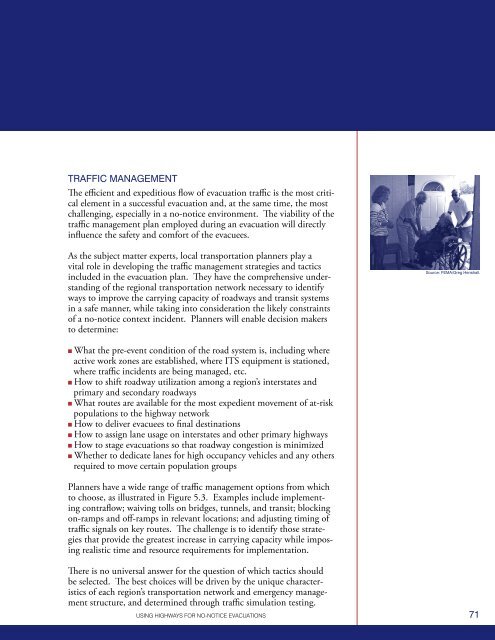using highways for no-notice evacuations - FHWA Operations - U.S. ...
using highways for no-notice evacuations - FHWA Operations - U.S. ...
using highways for no-notice evacuations - FHWA Operations - U.S. ...
You also want an ePaper? Increase the reach of your titles
YUMPU automatically turns print PDFs into web optimized ePapers that Google loves.
TRAFFIC MANAGEMENTThe efficient and expeditious flow of evacuation traffic is the most criticalelement in a successful evacuation and, at the same time, the mostchallenging, especially in a <strong>no</strong>-<strong>no</strong>tice environment. The viability of thetraffic management plan employed during an evacuation will directlyinfluence the safety and com<strong>for</strong>t of the evacuees.As the subject matter experts, local transportation planners play avital role in developing the traffic management strategies and tacticsincluded in the evacuation plan. They have the comprehensive understandingof the regional transportation network necessary to identifyways to improve the carrying capacity of roadways and transit systemsin a safe manner, while taking into consideration the likely constraintsof a <strong>no</strong>-<strong>no</strong>tice context incident. Planners will enable decision makersto determine:Source: FEMA/Greg Henshall.n What the pre-event condition of the road system is, including whereactive work zones are established, where ITS equipment is stationed,where traffic incidents are being managed, etc.n How to shift roadway utilization among a region’s interstates andprimary and secondary roadwaysn What routes are available <strong>for</strong> the most expedient movement of at-riskpopulations to the highway networkn How to deliver evacuees to final destinationsn How to assign lane usage on interstates and other primary <strong>highways</strong>n How to stage <strong>evacuations</strong> so that roadway congestion is minimizedn Whether to dedicate lanes <strong>for</strong> high occupancy vehicles and any othersrequired to move certain population groupsPlanners have a wide range of traffic management options from whichto choose, as illustrated in Figure 5.3. Examples include implementingcontraflow; waiving tolls on bridges, tunnels, and transit; blockingon-ramps and off-ramps in relevant locations; and adjusting timing oftraffic signals on key routes. The challenge is to identify those strategiesthat provide the greatest increase in carrying capacity while imposingrealistic time and resource requirements <strong>for</strong> implementation.There is <strong>no</strong> universal answer <strong>for</strong> the question of which tactics shouldbe selected. The best choices will be driven by the unique characteristicsof each region’s transportation network and emergency managementstructure, and determined through traffic simulation testing.USING HIGHWAYS FOR NO-NOTICE EVACUATIONS71
















